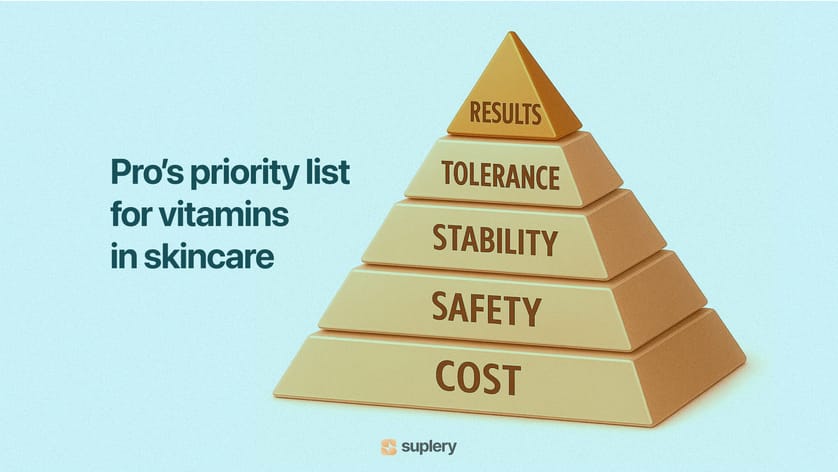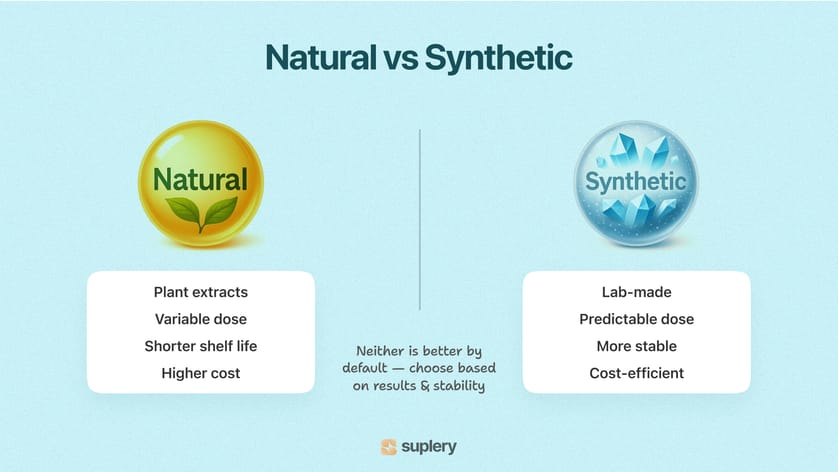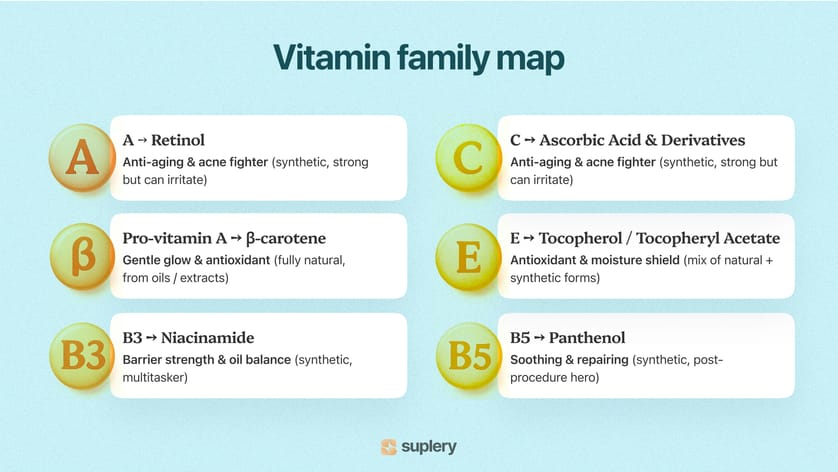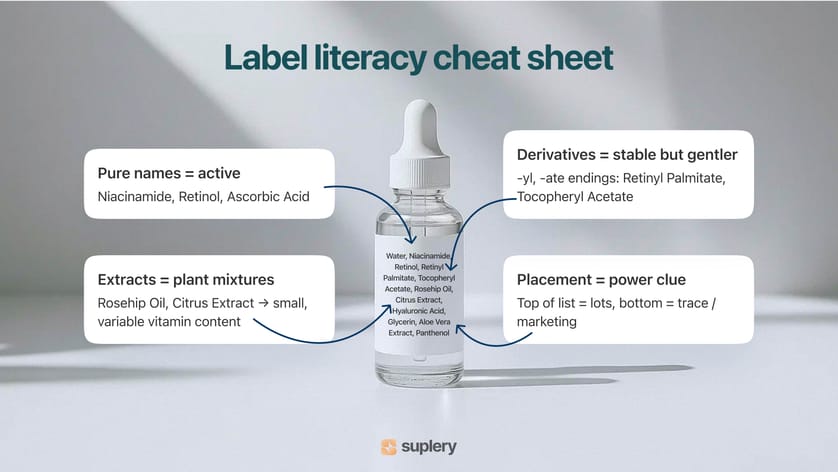Natural vs. synthetic vitamins: what really matters in pro beauty
You’ve heard it from clients a hundred times: “Is this natural?” The word gets tossed around on labels, in consultations, even in the comments on your salon’s Instagram. And vitamins are at the center of it — Vitamin C serums, retinol creams, Vitamin E masks, all packaged with some promise of being “natural” or “pure”, highlighting the role of natural ingredients in beauty marketing and the debate of natural vs synthetic vitamins in cosmetics. Clients often associate these words with promises of healthy skin, better skin tone, or formulas designed for sensitive skin.
But here’s the truth: in professional skincare, the question isn’t where the vitamin came from. It’s whether it works, whether it’s safe on skin (especially for acne prone skin or those with extremely sensitive skin), and whether it’s stable in the jar you’re about to open in the treatment room.
For pros, the order of importance is simple:
- Results
- Tolerance
- Stability
- Safety
- Cost
That’s it. If the vitamin can deliver visible results, won’t trigger irritation, holds up in storage with a longer shelf life, and is affordable enough to keep on your backbar or retail shelf — you’ll use it. The real question is whether it supports skin health, helps with collagen production, and protects against free radical damage that accelerates aging.
Clients don’t see it this way. They hear “synthetic” and picture something harsh and chemical, often worrying about synthetic ingredients or excessively high concentrations of actives. They hear “natural” and imagine safer, gentler care, better for their skin — especially for sensitive skin types or damaged skin. That gap is why you need to know how to explain the science clearly: what natural and synthetic really mean, how the skin responds to each, and when one is actually better than the other.
This guide will break it down. We’ll look at how vitamins are sourced, how natural and synthetic forms behave in cosmetic formulations, what that means for real performance in the treatment room, and how to talk about it with clients who care.
What “natural” and “synthetic” actually mean
Here’s where the confusion usually starts. “Natural” sounds clean and safe. “Synthetic” sounds chemical and scary. But in cosmetics, these words don’t mean what clients think they do — especially when we’re talking about natural vs synthetic vitamins in cosmetics.
Natural vitamins
- Come directly from plants, vegetable oils, or other natural materials.
- Example: Vitamin E from wheat-germ oil, or pro-vitamin A (beta-carotene) from rosehip or carrot oil.
- Usually arrive with “bonus ingredients”: other antioxidants, pigments, fatty acids, even fragrance. That makes the extract a cocktail — not just one vitamin — and sometimes supports skin’s barrier function and hydration alongside the vitamin itself.
Synthetic (or “nature-identical”) vitamins
- Are built in a lab — either by chemical synthesis, fermentation, or mass production. These are technically synthetic ingredients, designed for purity and stability.
- The goal is precision: you get a single, well-defined molecule at a known dose, reducing variability that can affect skin health and tone.
- Bonus: labs can tweak the structure into derivatives (like retinyl palmitate, sodium ascorbyl phosphate, or magnesium ascorbyl phosphate) to make it gentler, more stable, or easier to use on skin, even for acne prone skin or extremely sensitive skin.
The science reality
Your skin doesn’t carry a passport reader. It doesn’t care if Vitamin C came from an orange or a fermenter in Shanghai. What it “sees” is the molecule, the dose, and the delivery system — factors that directly influence skin health, collagen production, and skin cell turnover.
- If it’s the same molecule (like L-ascorbic acid or niacinamide), your skin uses it the same way to improve skin tone and support antioxidant activity.
- The real differences are in:– Consistency (a lab vitamin is the same every batch, a plant extract varies).– Stability (lab-made derivatives like sodium ascorbyl phosphate or retinyl palmitate can last months longer, maintaining potency and skin benefits).– Price (natural extraction is expensive, supply depends on harvests).– Marketing story (clients love “rosehip oil” on the label more than “ascorbic acid”).
✨ Why does one vitamin serum make your client’s skin light up… while another sits there like water? The answer lies in formulation, delivery, and how active ingredients resist free radical damage — the science behind it is in The Role of Vitamins in Modern Cosmetics.
Key takeaway for pros: “natural” means vitamin inside a broader extract, “synthetic” means pure and predictable. Neither is inherently better — it depends on what you need the vitamin to do in your treatment room.
For pros: how natural vs synthetic vitamins really compares
Now that we’ve cleared up what “natural” and “synthetic” mean, let’s get practical. You’re not stocking your backbar to win a science fair — you need vitamins that perform, hold up in storage, and fit your service pricing, while also protecting the skin barrier and minimizing skin irritation across different skin types.
Here’s the side-by-side view:
| What you care about | Natural source (extracts/oils) | Synthetic / nature-identical (pure actives & derivatives) | Pro takeaway |
|---|---|---|---|
Performance | Can work well, but vitamin levels are variable and often lower; may bring extra skin benefits like hydration or soothing. | Predictable dose; can choose potent or gentle derivatives for targeted results like treating acne or boosting collagen production. | For reliable results, synthetic is easier to dose. |
Stability | Sensitive to light, air, heat; shorter shelf life. | More stable or deliberately designed for longer shelf life. | For A & C, stabilized/encapsulated forms are essential. |
Tolerance | Often comfortable, but plant mixes can bring allergens (fragrance, proteins) and trigger skin irritation in extremely sensitive skin. | Ultra-pure, fewer unknowns; strong forms can still tingle/irritate if in high concentrations. | Match form + packaging to skin typeand sensitivity. |
Safety | Safe when well-made; risk is variability between harvests. | Safe when well-made; dosing is consistent and reduces risk of barrier disruption. | Both are safe in quality formulas — always patch test strong actives. |
Cost | Pricey and supply-dependent (crop yields, harvests). | Usually cost-efficient and scalable through mass production. | Predictable for setting service/retail pricing. |
Sustainability | Farming and harvest impact; nice “natural story.” | Factory/fermentation; often lower land/water use per gram. | No one-size-fits-all — look for brands that disclose sourcing. |
Label claims | “Naturally derived” sells well, but not a legal standard. | Marketed as “science-backed” and “stabilized.” | Don’t judge by the adjective, judge by the formula and active ingredients. |
👉 Bottom line for pros: results, safety, and cost matter more than the origin story. Clients may buy into “natural,” but your role is to know when the synthetic is actually delivering the unique benefits their skin needs.
Why we still use naturals
Even with all the advantages of synthetic vitamins, naturals have their place. Plant oils and extracts deliver a bundle of compounds — not just the vitamin, but also flavonoids, fatty acids, pigments, and botanical antioxidants. These extras can support skin hydration, aid in wound healing, calm inflammation, and provide a “story” that resonates with clients. In other words, naturals often bring more than the vitamin itself, both for skin feel and for client perception.
The pro’s guide to the most common vitamins
Not every vitamin shows up on your ingredient list the same way. Some are powerhouse workhorses (Vitamin A, Vitamin C, Niacinamide), others are gentle supporters (Panthenol, Vitamin E). Some are almost always synthetic, some can be both. Here’s how to read them.
Vitamin A (retinoids and carotenoids)
The classic anti-aging and acne fighter. Stimulates collagen production, boosts skin elasticity, speeds cell renewal and skin cell turnover, and reduces keratin plugs that clog pores. It’s also known for its role in wound healing and improving the overall look of damaged skin.
| You’ll see it as… | Common sourcing | What it means in practice |
|---|---|---|
Retinol, Retinyl Palmitate, Retinaldehyde | Almost always synthetic form | Reliable anti-age/acne effect, but can irritate and cause skin sensitivity. Needs smart packaging and a slow intro to avoid excessive skin irritation. |
Carotenoids (β-carotene, rosehip/carrot oils) | Natural oils/extracts | Gentler, more “natural” leaning. Effect is milder — think healthy glow and gradual tone improvement, not dramatic wrinkle reduction. |
Pro takeaway: Retinol = results, carotenoids = comfort. For strong anti-age effects, stick with stabilized synthetic forms like retinyl palmitate. For extremely sensitive skin or those new to actives, natural oils provide a softer entry point with added antioxidant activity.
Vitamin C (ascorbic acid + derivatives)
Beloved for brightening and collagen support. But also notorious for instability and sensitivity to UV damage and environmental damage.
| You’ll see it as… | Common sourcing | What it means in practice |
|---|---|---|
L-ascorbic acid | Synthetic vitamin C / fermentation | Gold standard for results (brightening, collagen production, UV defense) — but unstable. Needs airtight, opaque packaging and is often combined with stabilizers like ferulic acid for better antioxidant activity. |
Derivatives (Magnesium Ascorbyl Phosphate, Sodium Ascorbyl Phosphate, Calcium Ascorbate, Ascorbyl Glucoside, Ascorbyl Tetraisopalmitate, Ethyl Ascorbic Acid) | Synthetic, designed for stability | More stable and gentler. Conversion in skin varies — some weaker, some nearly as effective. Great for acne prone skin and reducing inflammation without irritation. |
Plant extracts (rosehip, acerola, camu-camu) | Natural | Provide Vitamin C plus flavonoids/antioxidants. Softer, more holistic, but usually lower % of active C. Best for supporting overall skin health and hydration. |
Pro takeaway: For clinical anti-age results, use stabilized synthetic formats such as sodium ascorbyl phosphate or calcium ascorbate. For sensitive skin or clients who value natural sourcing, berry and oil extracts give supportive antioxidant activity with less risk of irritation.
Vitamin E (tocopherols and tocotrienols)
Skin’s antioxidant bodyguard. Protects lipids, calms inflammation, supports the skin barrier, and helps maintain skin hydration.
| You’ll see it as… | Common sourcing | What it means in practice |
|---|---|---|
d-alpha-tocopherol | Natural vitamin E (plant oils) | More biologically active, but less stable. Adds richness, hydration, and strong antioxidant activity with additional protective benefits. |
dl-alpha-tocopherol (all-rac) | Synthetic | Similar activity, but a mix of isomers. Stable, cost-effective, widely used in cosmetic formulations. |
Tocopheryl Acetate | Synthetic, ester form | Super stable in a formula, but must convert to the active form in skin — not always efficient for immediate results. |
Pro takeaway: A mix works best. Natural vitamin E provides biologically active antioxidants and moisturizing support, while synthetic forms ensure stability and longer shelf life in skincare products.
Vitamin B3 (Niacinamide)
The industry’s multitasker: strengthens the skin barrier, balances sebum production, improves uneven tone, reduces redness, and helps with skin conditions like acne or sensitivity.
| You’ll see it as… | Common sourcing | What it means in practice |
|---|---|---|
Niacinamide (Nicotinamide) | Synthetic | Reliable, well-studied, tolerated by almost all skin. Improves barrier, tone, oil control, and reduces inflammation. |
Plant extracts (yeast, grains) | Natural | Contain some B3, but % is low. Added value from other nutrients, but not enough B3 for real results. |
Pro takeaway: If it says Niacinamide, it’s almost always synthetic — and that’s a good thing. It’s one of the safest, most versatile active ingredients in modern skincare routines, with unique benefits across nearly all skin types.
Vitamin B5 (Panthenol)
Known for soothing and hydration. Also referred to as pantothenic acid, this vitamin plays an important role in wound healing, maintaining skin elasticity, and reducing inflammation after irritation or procedures.
| You’ll see it as… | Common sourcing | What it means in practice |
|---|---|---|
Panthenol (D-Panthenol) | Synthetic | Converts in skin to B5. Strong humectant, barrier repair, reduces inflammation, and accelerates wound healing. Great post-procedure when the skin barrier needs fast recovery. |
Honey, royal jelly, oat extracts | Natural | Contain B5, but at variable and much lower levels, so not always effective unless formulated correctly. |
Pro takeaway: Panthenol in formulas is almost always synthetic — and that’s a good thing. Predictable dose, great safety, easy to use across skin and hair, making it one of the most reliable active ingredients in skincare routines.
Vitamin K
A niche player, mostly for vascular issues like dark circles or post-procedure bruising.
| You’ll see it as… | Common sourcing | What it means in practice |
|---|---|---|
Vitamin K1 (Phylloquinone / Phytonadione) | Synthetic | Used in eye creams and post-procedure care. Can reduce appearance of dark circles, bruising, and speed up recovery after treatments. |
Botanicals (parsley, spinach extracts) | Natural | Contain K, but rarely at functional levels in cosmetics. Mostly included for the marketing story, not performance. |
Pro takeaway: Almost always synthetic in cosmetics. Safe, mild, and works best when formulated correctly in combination with caffeine, retinol, or Vitamin C for enhanced results around the eyes and vascular skin concerns.
Beta-carotene (Pro-vitamin A)
A gentle antioxidant and natural source of Vitamin A. Supports skin tone, adds a subtle healthy glow, and helps protect against free radical damage. Less potent than retinol, but a great option for sensitive skin or clients who want a more natural approach to pro-aging care.
| You’ll see it as… | Common sourcing | What it means in practice |
|---|---|---|
Natural oils and plant extracts (carrot oil, rosehip, pumpkin, spinach) | Natural | Works as an antioxidant, gradually improves radiance, and can convert to Vitamin A in skin — though less efficiently than retinol. Great for barrier support and hydration. |
Pro takeaway: Beta-carotene offers a softer, slower route to Vitamin A benefits — perfect for sensitive, dry, or barrier-compromised skin. It won’t deliver dramatic wrinkle reduction like retinol, but it adds antioxidant protection and long-term skin support.
How to read a package like a pro
Clients see “with Vitamin C” and feel good.
You see Ascorbic Acid vs Ascorbyl Glucoside and instantly know which one will hold up. This kind of label literacy is what defines clear cosmetics — skincare products where the ingredient list is transparent, the active ingredients are easy to identify, and the chemical structure actually explains performance on the skin. This is exactly how cosmetic chemists think when they evaluate a formula.
Here’s a cheat sheet:
Ingredient names = passports
- INCI names (International Nomenclature of Cosmetic Ingredients) are standardized globally.
- If it says Niacinamide, it always means the same thing, whether the cream is from Tokyo or Paris.
- If it says Mixed Tocopherols, it’s a blend — exact content and potency unknown.
Endings matter
- -yl or -ate endings usually mean a derivative (a modified chemical structure for stability or gentleness):
- Retinyl Palmitate = stabilized form of Vitamin A.
- Tocopheryl Acetate = ester form of Vitamin E, more stable but slower to activate in skin.
- Ascorbyl Palmitate = fat-soluble Vitamin C derivative.
- A plain name usually signals the pure active:
- Niacinamide, Retinol, Tocopherol, Ascorbic Acid.
- These are often more potent but also more prone to instability, irritation, or faster penetration into the stratum corneum.
Group vs single
- A group/botanical name means you’re getting a mixture, not a precise dose:
- “Citrus Extract” = may contain trace Vitamin C, but also fragrance compounds, flavonoids, sugars. These blends can bring unique benefits, but are harder to measure and depend heavily on whether they are formulated correctly in cosmetic products.
- A single chemical name means you’re getting a defined, measurable active:
- “Ascorbic Acid” = a known molecule at a measurable concentration with clear, predictable skin benefits.
Placement on the list matters
- Ingredients are listed by descending weight (at least above 1%).
- If Vitamin C is the 15th item, it may be at a trace amount — great for marketing, not so much for real results.
- If it’s near the top, or if the packaging lists the actual percentage (e.g. “10% Niacinamide”), you can trust it’s at an active level that supports visible skin improvements.
Packaging tells a story
- Pure Vitamin C and Retinol hate air and light. If they’re in a clear jar with a wide lid, potency won’t last, and the product may lose effectiveness before use.
- Look for dark glass, pumps, or single-dose capsules to protect unstable actives from environmental damage like oxidation.
- Stable derivatives (like Niacinamide or Panthenol) are less fussy and can handle jars without compromising their skin benefits.
Best practices for pros
- Use INCIDecoder, the EU CosIng database, or PubChem to double-check ingredients.
- Even AI tools can help: try asking “Explain what these three INCI names mean for skin tolerance and stability.”
- Build the habit of scanning INCI like you’d scan an ingredient list in a kitchen — the details matter.
👉 Pro tip for client communication: “Natural” is not a legally defined word in cosmetics. The INCI list is the real truth, no matter how the cosmetic product is marketed.
How to talk about it with clients
Here’s what you’ll actually hear in the chair — and pro-friendly ways to answer:
- “Synthetic = chemicals = bad.”→ “Everything is a chemical — water is a chemical. What matters is whether the molecule is safe and effective. Lab-made vitamins are often purer, more stable, and can be formulated correctly to actually improve skin.”
- “Natural is safer.”→ “Natural oils and extracts can be wonderful, but they also carry allergens and spoil faster. Sometimes the lab-made version is actually gentler on sensitive skin and even reduces inflammation more effectively.”
- “Natural works better because it’s complete.”→ “Plant extracts often bring extra antioxidants, which is great for general support and protective benefits. But if we need a proven result — like fading pigment spots or treating skin conditions — the pure, stabilized vitamin works faster.”
- “This says natural Vitamin C — is that better?”→ “It’s the same Vitamin C molecule. The real question is: how stable is it in the formula, and is the packaging protecting it until you use it? Stability is what determines real skin benefits.”
Clients ask about “natural vs synthetic” because they care about safety and identity. But in the treatment room, what matters is:
- Does it work?
- Will my client tolerate it — even with sensitive skin or existing skin conditions?
- Will it stay stable until I open it?
- Can I afford to use it consistently in my skincare routines and treatments?
Natural extracts shine when you want gentle support, a holistic “story,” or extra antioxidants bundled together. Synthetic (or nature-identical) vitamins shine when you need precision, potency, and predictable results.
👉 Your role as a pro: guide the client past the label and toward the result. “Natural” and “synthetic” may sell the story — but results, stability, and safety are what keep clients coming back.
And the real beauty win? When you stop debating origins and start delivering outcomes that improve skin health and resilience.
 Elevate your glow with proven beauty secrets
Elevate your glow with proven beauty secrets
Dive in now for the latest beauty hacks, expert-approved tips, and transformative routines!
Oh no! We couldn’t subscribe you ☹️
Done! You've subscribed 💛
Unsubscribe anytime. Your data is stored for business-to-business communication purposes. See our Privacy policy.
Frequently asked questions
Do natural vitamins work better than synthetic?
Not always. If the chemical structure is identical (like L-ascorbic acid), the skin sees no difference. Natural extracts may add extra antioxidants, but synthetic vitamins in cosmetic products give precise doses that often deliver faster results.
Are natural vitamins always safer?
No. Natural oils can trigger allergies, while lab-made actives are purified. But both natural and synthetic can cause skin irritation in high concentrations — it’s all about being formulated correctly.
Which vitamins are usually synthetic?
Most retinoids, niacinamide (B3), panthenol (B5/pantothenic acid), and Vitamin K are almost always synthetic forms for stability and consistency.
Which vitamins can be both?
Vitamin E (natural vitamin E from plant oils vs. synthetic acetate) and Vitamin C (from berries or as synthetic vitamin C derivatives like sodium ascorbyl phosphate or calcium ascorbate).
Do synthetic vitamins give faster results?
Yes — synthetic retinol boosts cell renewal, niacinamide balances sebum production, and stabilized Vitamin C improves skin tone within weeks. Natural extracts usually work more gently and slowly.
Which last longer on the shelf?
Synthetic derivatives like magnesium ascorbyl phosphate or tocopheryl acetate are built for a longer shelf life. Natural oils can oxidize quickly if not protected from environmental damage.
Which are safest for sensitive skin?
Niacinamide, panthenol, and carotenoids are considered the gentlest. Retinol or strong Vitamin C can irritate the stratum corneum if used in excessively high concentrations.
Can you mix natural and synthetic vitamins?
Absolutely. Many of the best skincare routines combine them — e.g. synthetic retinol for wrinkles plus rosehip oil for unique benefits like soothing and hydration.
Last updated on Oct 02, 2025
This is a brand-new guide on natural vs synthetic vitamins in professional beauty — covering sourcing, stability, skin impact, and client communication with updated science.
Please share this post
Table of Contents
What “natural” and “synthetic” actually meanFor pros: how natural vs synthetic vitamins really comparesThe pro’s guide to the most common vitaminsVitamin A (retinoids and carotenoids)Vitamin C (ascorbic acid + derivatives)Vitamin E (tocopherols and tocotrienols)Vitamin B3 (Niacinamide)Vitamin B5 (Panthenol)Vitamin KBeta-carotene (Pro-vitamin A)How to read a package like a proHow to talk about it with clientsFrequently asked questionsThe role of vitamins in modern cosmetics
Ever wondered if natural Vitamin C is better than synthetic ascorbic acid? Or why synthetic Vitamin E is so common in skincare? This article explains the real differences, benefits, and myths about vitamins in cosmetics — so you can choose wisely.
Chemistry of beauty
11 min
Can I use hyaluronic acid and tretinoin together? Is it safe?
We break down what hyaluronic acid and tretinoin do, the pros and cons of using them together, and step-by-step tips to achieve that radiant glow. We'll help you combine these powerhouses safely and effectively!
Chemistry of beauty
6 min
10 benefits of alginate masks for flawless skin
Dive into the wonders of alginate masks! Uncover what they are and explore why they're an absolute necessity for your skincare routine.
Chemistry of beauty
8 min
Unlock FREE bonus material!
Get your hands on "50 sample service ideas to boost salon revenue". Subscribe to our newsletter and receive a link to download it straight to your inbox.
Oh no! We couldn’t subscribe you ☹️
Done! We've sent a link to your Email 📨
Trusted by the best in the beauty industry.
Transform your beauty business with Suplery!
Already enjoying our expert tips? Take the next step and join Suplery to revolutionize your business operations.
Huge range of professional products
One-click checkout after first order
Automated predictive orders
Seamless inventory management
From words to action
Start working with Suplery and explore all the tools and services you need to expand your business
Get started with Suplery24/7 Support
Secure payments
Designed by industry’s experts









